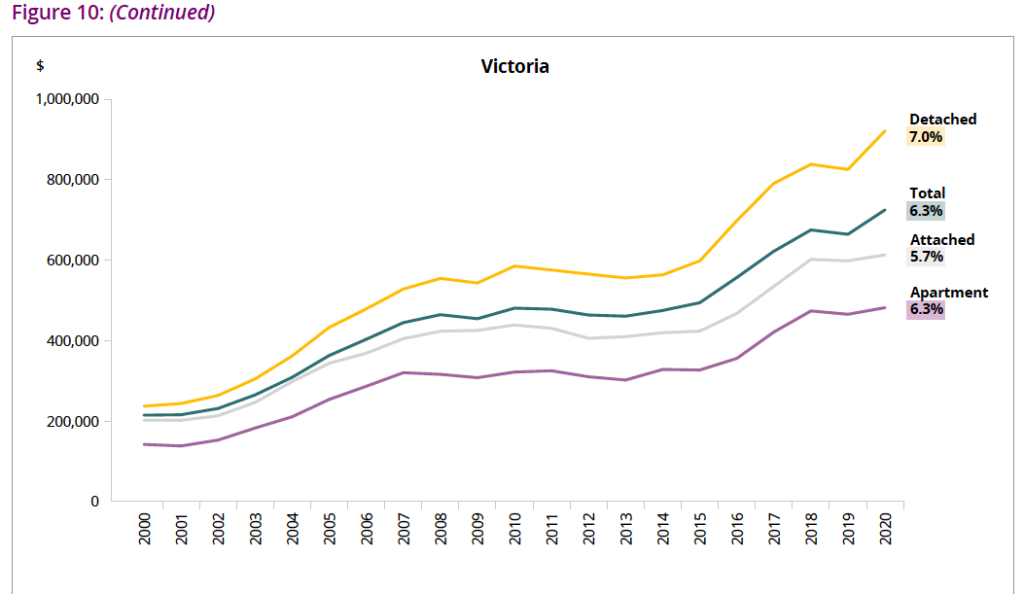
As she sanitized the knob of my office door, one of the City’s newest employees, who keeps our offices COVID clean said to me when we met recently, “Nice to meet you; thanks for building the city for the future.”
I was so struck by this because this is exactly what we’ve been doing for the last six and a half years. From the bike network, to the Climate Leadership Plan, to Zero Waste Victoria, to the Accessibility Framework, to Victoria 3.0, to the Witness Reconciliation Program and the Reconciliation Dialogues, and more. We’ve moved Victoria from 20th-century approaches to city building and oriented our city towards the 22nd century.
The one exception is housing and land use. There we’re still very much stuck in the 20th century. And we are very close to a tipping point, in the wrong direction. Unless the City and the Province make some bold moves soon, we will be responsible for creating a low-affordability future where the next generations of families and working people will be priced out of the city. We’ll lose artists, creatives, daycare workers, young professionals. We’ll lose our arts and culture scene. All of Victoria’s cherished strengths will be steadily eroded and undermined.
Whether you’re for or against townhouses being allowed in every neighbourhood, or for or against taller buildings downtown and in Harris Green, I imagine no one would willingly work create to this kind of future. So what can we do?
Single Family Dwellings: So few can afford them, so why are they so easy to build?
Currently, the City’s land use policies and procedures make it easier to build a single family home than any other type of dwelling, even though this is the most expensive form of housing that few people can afford.
Want to knock down a single family home and build a bigger one? No problem. This only needs staff – not Council – approval. And it doesn’t take too long to get the permits needed. Want to build a triplex, or houseplex or townhouses – what’s known as “missing middle housing” – on lots that are currently zoned for single family homes?
- Start by holding a Community Association Land Use Committee (CALUC) meeting.
- Incorporate the feedback you receive at the CALUC meeting into your plans.
- Submit your rezoning application and development permit application to the City.
- Staff will then review your application, including an interdepartmental review that usually involves both the Parks and Engineering departments.
- Then your application will be sent to a Committee of the Whole meeting for review by Council. If you’re lucky, Council accepts the staff recommendation to move the project forward. But Council always has the prerogative to refer the application back to staff to work with the applicant to make changes. If this happens, go back to step 3; if there are substantive changes, go back to step 1 for another CALUC meeting.
- If you get past Committee of the Whole, two weeks later the application is voted on at Council. It could get turned back or turned down here.
- If it passes at Council, months are usually needed to prepare all the legal agreements required before proceeding to a public hearing.
- Once all the legal agreements are prepared, one more trip to Council before heading to public hearing; that’s at a Council meeting where first and second reading of the bylaws are considered. Council could turn down or turn back the proposal at this point too.
- After first and second reading of the bylaws, a public hearing date is scheduled and advertised to the public in the newspaper, as is required by provincial legislation.
- At the public hearing, the public gets to share their thoughts and concerns about the project. And then, that night, Council makes a decision.
This whole process can take often take a year, or more.
Unless there are efforts by the developer to rally support for the proposed new housing – which is often seen as suspect by Council and some members of the public – public hearings are usually mostly attended by people who live in single family dwellings nearby the proposed duplex, houseplex or townhouse who are opposed to the new housing. As the Canada-BC Expert Panel on the Future of Housing Supply and Affordability put it in their recently released report, “Rezoning can be difficult and amplifies the voices of a few rather than the needs of the community at large.”

So we’re making it easiest to build the most expensive form of housing, and we’re pricing people out of our city.
Later this month, City staff will be bringing a report on missing middle housing to Council. They will recommend changes that make it much easier to build the kind of housing that people in Victoria need and can afford. I hope staff recommend taking away Council’s ability to vet these proposals, and delegating the entire process to staff. In short, I hope we start to treat duplexes, houseplexes and town houses just as we currently treat single family homes. I can’t think of a logical reason why we wouldn’t at least try this given that so few working people can afford a million dollar home.
Beyond Single Family Homes: What about housing supply in Victoria more generally?
While the Canada-BC Expert Panel was hard at work, so too were City staff. The recently released, “Victoria’s Housing Future,” report looks at current and future housing needs in our city. When staff presented their report to Council and the public a few weeks ago, one of the City’s housing staff and report authors reminded us that, “We’re planning for people, not just to accommodate growth.”
There is a narrative out there in the public that goes something like: “There’s so much construction and building already changing our city. Why should we welcome more people to Victoria and change our city so much that we don’t recognize it, just to accommodate people who don’t live here yet?”
Starkly, what “Victoria’s Housing Future” reveals is that as of 2016 (the most recent census data and five years out of date), we are between 4500 and 6300 homes short for the people who are already living here. Where are all these people now?

This estimated housing gap of between 4500 and 6300 homes for existing residents is based on these factors. It’s likely a conservative estimate of how much catching up is needed. According to “Victoria’s Housing Future”, “Even if 7000 units were added to the market today, we’d likely still feel some of the same pressures we’re already facing.”
To help out our residents who are already living here in overcrowded, or unaffordable housing, and to help employers who can’t keep workers because they can’t afford to live here, Council should not be allowed to turn down any proposal for new homes that fits within the City’s Official Community Plan (OCP), until we close the 7000 unit gap.
Here’s what the OCP says about Land Management and Development:

“Victoria’s Housing Future” also reveals that even if the OCP is built out to meet the housing need anticipated by 2041, we will still be 20-30% under the number of homes projected to be needed. What this means is that we need to revise the OCP to create more “urban residential” land and less “traditional residential.”

Traditional residential means:
- Ground-oriented buildings up to two storeys
- Ground-oriented buildings up to two and one-half storeys may be considered for certain infill housing types
- Multi-unit buildings up to three storeys, including attached residential and apartments on arterial and secondary arterial roads
- Houses with front and rear yards oriented to face the street
- Variable landscaping and street tree planting
- Small apartments and local retail stores along arterial and secondary arterial roads and at intersections
- On-street parking and individual driveways
Urban residential means:
- Attached and detached buildings up to three storeys
- Low-rise and mid-rise multi-unit buildings up to approximately six storeys
- Primary doorways facing the street
- Front yard landscaping, boulevard and street tree planting
- On-street parking and collective driveway access to rear yard or underground parking
Shifting more of the city’s limited land base from traditional residential to urban residential doesn’t mean drastically changing the character of our neighbourhoods. It means doing more with our limited land base. And, it means doing this in order to meet not only our housing targets but also our climate goals. If we don’t make more room for housing in the city, what will happen is what is happening – more forests will be destroyed to build housing in the suburbs.
What can we do to make sure there is enough room in Victoria for artists, innovators, families, seniors, the next seven generations?
The Canada-BC Expert Panel on the Future of Housing Supply makes some good recommendations that the Province should implement immediately. Low hanging fruit includes mandating no public hearings for any buildings that fit within a City’s OCP. The panel also recommends that cities update zoning to match their OCPs and delegate development permits to staff. This means that there will be no political decisions and no public input for new housing on a development by development basis, as long as proposed new homes fit with what the OCP envisions.
While it may feel to some that these changes will cut the public out of the process, what they’re meant to do is a open up a more robust and vision-oriented public dialogue that happens as OCPs and design guidelines are developed and as City-initiated rezonings come forward. This kind of big-picture dialogue isn’t happening through the current public hearing process which pits existing neighbours against future neighbours against Council against developers.
Instead, we could ask questions that require us all to think bigger than whether we are for or against a certain proposal, questions like:
- How might we enhance Victoria’s character and the neighbourhoods we all love at the same time as making room for current and future residents to have the housing they need at every phase and stage of their lives?
- How might we protect existing older rental buildings and the affordability that comes with them, at the same time as making the most of the limited land base we have in the city?
- How might we ensure that as our city grows and has more tall buildings as envisioned in the OCP, we also create more public spaces, green spaces, and enhance biodiversity?
It’s in answering these questions together that we’re going to build a more inclusive, resilient city, a city for everyone, and for the future.




